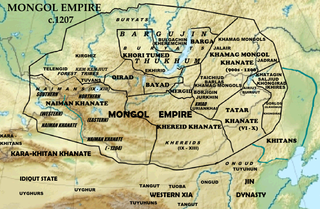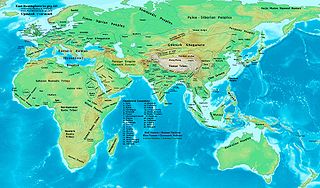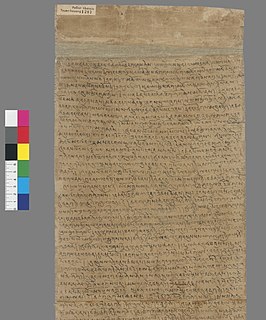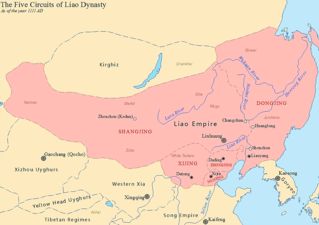
Tibetan history, as it has been recorded, is particularly focused on the history of Buddhism in Tibet. This is partly due to the pivotal role this religion has played in the development of Tibetan and Mongol cultures and partly because almost all native historians of the country were Buddhist monks.

A Borjigin is a member of the Mongol sub-clan, which started with Yesugei of the Kiyat clan. Yesugei's descendants were thus said to be Kiyat-Borjigin. The senior Borjigids provided ruling princes for Mongolia and Inner Mongolia until the 20th century. The clan formed the ruling class among the Mongols and some other peoples of Central Asia and Eastern Europe. Today, the Borjigid are found in most of Mongolia, Inner Mongolia and Xinjiang, and additionally genetic research has shown that descent from Genghis Khan is common throughout Central Asia and other regions.

Songtsen Gampo, also Songzan Ganbu, was the 33rd Tibetan king and founder of the Tibetan Empire, and is traditionally credited with the introduction of Buddhism to Tibet, influenced by his Nepali consort Bhrikuti, of Nepal's Licchavi dynasty, as well as with the unification of what had previously been several Tibetan kingdoms. He is also regarded as responsible for the creation of the Tibetan alphabet and therefore the establishment of Classical Tibetan, the language spoken in his region at the time, as the literary language of Tibet.
The Altan Tobchi, or Golden Summary, is a 17th-century Mongolian chronicle written by Guush Luvsandanzan. Its full title is Herein is contained the Golden Summary of the Principles of Statecraft as established by the Ancient Khans. Mongolian scholars typically call the work the "Lu Altan Tovch". It is generally considered second in dignity to the Secret History of the Mongols as a historical chronicle and piece of classical literature. In fact, the work is special in that it contains 233 of the 282 chapters of the Secret History not only verbatim but with additional detail in certain parts. It is also significant in that it is a major source of knowledge on the "Chingisiin Bilig" or Wisdom of Genghis, a code of ethical conduct specifically directed toward future generations of Mongolian ruling nobility. Duke Jamiyan discovered and brought the original pen copy of the Altan Tobchi to Ulaanbaatar in 1926 from a Taiji called Dari living in Dornod Province, Mongolia. It was studied in depth by Jamsrangiin Tseveen and Byambyn Rinchen, and was translated into English by Charles Bawden in 1955. It is one of the most frequently quoted sources in Mongolian publications.
The family tree of Genghis Khan is listed below. This family tree only lists prominent members of the Borjigin family and does not reach the present. Genghis Khan appears in the middle of the tree, and Kublai Khan appears at the bottom of the tree. The Borjigin family was the royal family of the Mongol Empire, dating back to the 13th and 14th centuries.

Tuyuhun, also known as Azha, was a dynastic kingdom established by the nomadic peoples related to the Xianbei in the Qilian Mountains and upper Yellow River valley, in modern Qinghai, China.

The Tayichiud was one of the three core tribes of the Khamag Mongol confederation in Mongolia during the 12th century.

Ligden Khutugtu Khan or Lindan Han (林丹汗) was the last khan of the Northern Yuan dynasty based in the Mongolian Plateau as well as the last in the Borjigin clan of Mongol Khans who ruled the Mongols from Chakhar. His unpopular reign generated violent opposition due to his harsh restrictions over the Mongols. His alliance with Ming dynasty of China, sponsorship of Tibetan Buddhism in Chakhar and reorganization of Mongolian political divisions were ineffective when the Qing dynasty became the major power in East Asia.
The first military conflict between China and Tibet occurred in 638. In the early 7th century, the westward conquests of the Chinese Tang dynasty brought it into contact with the rising Tibetan Empire. When Emperor Taizong of Tang refused a marriage alliance, the Tibetan emperor Songtsen Gampo sent an army to attack the Chinese frontier city of Songzhou. After a Tang army inflicted heavy casualties on the Tibetans in a night-time attack, Songtsen Gampo withdrew. He sent emissaries and tributes to Chang'an to apologize, and to again request marriage. Taizong decided to give Songtsen Gampo a distant niece, Princess Wencheng, in marriage. The peace held for the remainder of the reigns of Taizong and Songtsen Gampo, although Tibet would pose major military threats for most of the rest of the Tang period.
Namri Songtsen, also known as "Namri Löntsen" (570?–618?/629) was, according to tradition, the 32nd King of Tibet of the Yarlung Dynasty, which until his reign ruled only the Yarlung Valley. He expanded his kingdom to rule the central part of the Tibetan Plateau. His actions were decisive in the setting up of the Tibetan Empire, to which he can be named co-founder with his son, Songtsen Gampo.

The Tibetan Empire existed from the 7th to 9th centuries AD when Tibet was unified as a large and powerful empire, and ruled an area considerably larger than the Tibetan Plateau, stretching to parts of East Asia, Central Asia and South Asia.
The Sumpa were a tribe living in northeastern Tibet from ancient times. Chinese historical sources refer to them as "Qiang", a term for people living in what is now Southwest China, and their actual ethnic identity is not known. Their territory was absorbed by the Tibetan Empire in the late 7th century, after which point they gradually lost their independent identity.

The Old Tibetan Chronicle is a collection of narrative accounts and songs relating to Tibet's Yarlung dynasty and the Tibetan Empire. The three manuscripts that comprise the only extant copies of the Chronicle are among the Dunhuang Manuscripts found in the early 20th century in the so-called "hidden library" at the Mogao Grottoes near Dunhuang, which is believed to have been sealed in the 11th century CE. The Chronicle, together with the Old Tibetan Annals comprise Tibet's earliest extant history.

There were several Mongol invasions of Tibet. The earliest is the alleged plot to invade Tibet by Genghis Khan in 1206, which is considered anachronistic; there is no evidence of Mongol-Tibetan encounters prior to the military campaign in 1240. The first confirmed campaign is the invasion of Tibet by the Mongol general Doorda Darkhan in 1240, a campaign of 30,000 troops that resulted in 500 casualties. The campaign was smaller than the full-scale invasions used by the Mongols against large empires. The purpose of this attack is unclear, and is still in debate among Tibetologists. Then in the late 1240s Mongolian prince Godan invited Sakya lama Sakya Pandita, who urged other leading Tibetan figures to submit to Mongol authority. This is generally considered to have marked the beginning of Mongol rule over Tibet, as well as the establishment of patron and priest relationship between Mongols and Tibetans. These relations were continued by Kublai Khan, who founded the Mongol Yuan dynasty and granted authority over whole Tibet to Drogon Chogyal Phagpa, nephew of Sakya Pandita. The Sakya-Mongol administrative system and Yuan administrative rule over the region lasted until the mid-14th century, when the Yuan dynasty began to crumble.

Tibet under Yuan rule refers to the Yuan dynasty's rule over Tibet from approximately 1270 to 1354. During the Yuan rule of Tibet, the region was structurally, militarily and administratively controlled by the Mongol-led Yuan dynasty of China, a division of the Mongol Empire. In the history of Tibet, Mongol rule was established after Sakya Pandita got power in Tibet from the Mongols in 1244, following the 1240 Mongol conquest of Tibet led by the Mongol general with the title doord darkhan. It is also called the Sakya dynasty after the favored Sakya school of Tibetan Buddhism.

The Yarlung dynasty, or Pre-Imperial Tibet, was a proto-historical dynasty in Tibet before the rise of the historical Tibetan Empire in the 7th century.

Bodonchar Munkhag was a renowned Mongol warlord and a direct ancestor of Genghis Khan as well as of the Barlas Mongols, the tribe of the Central Asian warlord Timur.

This is a timeline of Mongols prior to the Mongol Empire.

Tengri Khan was the First Leader or Khan of the Tengri Tribe who ruled in 620 c. The name Tengri Khan was adopted by him when he was appointed Khan. His actual name is unknown, with no records of his name ever found. His name was given to the tribe he ruled, the "Tengri tribe". He was born near the beginning of the 7th Century, and was a Yarlung dynasty prince and the son of Namri Songtsen, the 32nd Emperor of the Tibetan Empire. However, he did not succeed his father directly; his older brother Songtsen Gampo was the first successor and the first founder of the Tibetan Empire in 618. Tengri Khan decided to leave on a journey to establish his own tribal kingdom, which was named the Tengri Khan tribe, the tribe that ruled the kingdom until their downfall.











